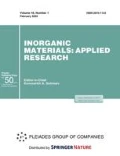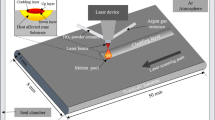Abstract
The effect of intermediate ion cleaning of the Ti target on the structure and properties of the polymer fiber scaffold made by electrospinning from poly-L-lactic acid (PLLA) was investigated during deposition of Ti-N-containing coatings by DC reactive magnetron sputtering of the Ti target in a nitrogen atmosphere. SEM investigation shows that the selected plasma treatment modes can modify fiber PLLA scaffolds without changing their morphological properties. Energy-dispersive spectroscopy showed that the Ti concentration on the surface of PLLA scaffolds is increased under intermediate ion cleaning of the target, although ion cleaning did not affect the Ti distribution across the scaffold cross section. Using optical goniometry, it was found that scaffold surface treatment allows changing the contact properties of the surface from hydrophobic to hydrophilic.


Similar content being viewed by others
REFERENCES
Long, Y., Biodegradable Polymer Blends and Composites from Renewable Resources, Chichester: Wiley, 2008.
Volkov, A.V., Synthetic biomaterials based on polymers of organic acids in tissue engineering, Kletochnaya Transplatologiya Tkanevaya Inzh., 2005, no. 2, pp. 43–45.
Antonova, L.V., Matveeva, V.G., and Barbarash, L.S., Electrospinning and biodegradable small-diameter vascular grafts: problems and solutions (review), Kompl. Probl. Serdechno-Sosudistykh Zabol., 2015, no. 3, pp. 12–22.
Bhardwaj, N. and Kundu, S.C., Electrospinning: a fascinating fiber fabrication technique, Biotechnol. Adv., 2010, vol. 28, no. 3, pp. 325–347.
Gorelova, A.A., Murav’ev, A.N., Vinogradova, T.I., et al., Tissue-engineering technology in urethral reconstruction, Med. Al’yans, 2018, no. 3, pp. 75–82.
Koerner, R.J., Butterworth, L.A., Mayer, I.V., Dasbach, R., and Busscher, H.J., Bacterial adhesion to titanium-oxynitride (TiNOX) coatings with different resistivities: a novel approach for the development of biomaterials, Biomaterials, 2002, vol. 23, no. 14, pp. 2835–2840.
Musil, J., Baroch, P., Vlček, J., Nam, K.H., and Han, J.G., Reactive magnetron sputtering of thin films: present status and trends, Thin Solid Films, 2005, vol. 475, nos. 1–2, pp. 208–218.
Cyster, L.A., Parker, K.G., Parker, T.L., and Grant, D.M., The effect of surface chemistry and nanotopography of titanium nitride (TiN) films on primary hippocampal neurons, Biomaterials, 2004, vol. 25, no. 1, pp. 97–107.
Arnell, R.D. and Kelly, P.J., Recent advances in magnetron sputtering, Surf. Coat. Technol., 1999, vol. 112, no. 1–3, pp. 170–176.
Martins, A., Pinho, E.D., Faria, S., Pashkuleva, I., Marques, A.P., Reis, R.L., and Neves, N.M., Surface modification of electrospun polycaprolactone nanofiber meshes by plasma treatment to enhance biological performance, Small, 2009, vol. 5, no. 10, pp. 1195–1206. https://doi.org/10.1002/smll.200801648
Bolbasov, E.N., Maryin, P.V., Stankevich, K.S., Goreninskii, S.I., Kudryavtseva, V.L., Mishanin, A.I., Golovkin, A.S., Malashicheva, A.B., Zhukov, Y.M., Anissimov, Y.G., and Tverdokhlebov, S.I., Nitrogen-doped titanium dioxide thin films formation on the surface of PLLA electrospun microfibers scaffold by reactive magnetron sputtering method, Plasma Chem. Plasma Process., 2019, vol. 39, no. 2, pp. 503–517.
Bolbasov, E.N., Antonova, L.V., Stankevich, K.S., Ashrafov, A., Matveeva, V.G., Velikanova, E.A., Khodyrevskaya, Yu.I., Kudryavtseva, Yu.A., Anissimov, Y.G., Tverdokhlebov, S.I., and Barbarash, L.S., The use of magnetron sputtering for the deposition of thin titanium coatings on the surface of bioresorbable electrospun fibrous scaffolds for vascular tissue engineering: A pilot study, Appl. Surf. Sci., 2016, vol. 398, pp. 63–72.
Tverdokhlebov, S.I., Bolbasov, E.N., Shesterikov, E.V., Antonova, L.V., Golovkin, A.S., Matveeva, V.G., and Anissimov, Y.G., Modification of polylactic acid surface using RF plasma discharge with sputter deposition of a hydroxyapatite target for increased biocompatibility, Appl. Surf. Sci., 2015, vol. 329, pp. 32–39.
Arif, M. and Eisenmenger-Sittner, C., In situ assessment of target poisoning evolution in magnetron sputtering, Surf. Coat. Technol., 2017, vol. 324, pp. 345–352.
Bolbasov, E.N., Maryin, P.V., Stankevich, K.S., Kozelskaya, A.I., Shesterikov, E.V., Khodyrevskaya, Y.I., and Tverdokhlebov, S.I., Surface modification of electrospun poly-(L-lactic) acid scaffolds by reactive magnetron sputtering, Colloids Surf., B, 2018, vol. 162, pp. 43–51.
Barbarash, L.S., Bolbasov, E.N., Antonova, L.V., Matveeva, V.G., Velikanova, E.A., Shesterikov, E.V., and Tverdokhlebov, S.I., Surface modification of poly-ε-caprolactone electrospun fibrous scaffolds using plasma discharge with sputter deposition of a titanium target, Mater. Lett., 2016, vol. 171, pp. 87–90.
Kelly, P.J. and Arnell, R.D., Magnetron sputtering: a review of recent developments and applications, Vacuum, 2000, vol. 56, no. 3, pp. 159–172.
Townsend, P.D., Kelly, J.C., and Hartley, N.E.W., Ion Implantation, Sputtering and Their Applications, London: Academic, 1976.
Sputtering by Particle Bombardment I: Physical Sputtering of Single-Element Solids, Behrisch, R., Ed., Berlin: Springer, 1981.
Funding
This work was supported by the Ministry of Science and Higher Education of the Russian Federation under the Federal Target Program, agreement no. 14.575.21.0140, unique identifier RFMEFI57517X0140.
Author information
Authors and Affiliations
Corresponding author
Ethics declarations
The authors declare that they have no conflicts of interest.
Additional information
Translated by K. Lazarev
Rights and permissions
About this article
Cite this article
Maryin, P.V., Ivanova, N.M., Shesterikov, E.V. et al. Effect of Intermediate Ion Cleaning of the Titanium Target on the Structure of Bioresorbable PLLA Scaffolds under Coating Deposition by DC Reactive Magnetron Sputtering. Inorg. Mater. Appl. Res. 11, 646–652 (2020). https://doi.org/10.1134/S2075113320030326
Received:
Revised:
Accepted:
Published:
Issue Date:
DOI: https://doi.org/10.1134/S2075113320030326




